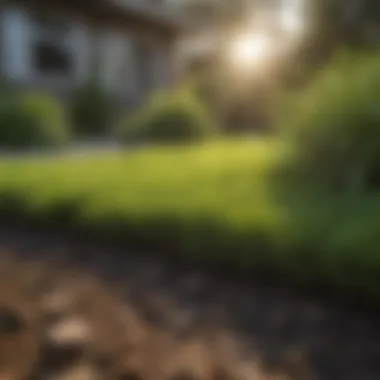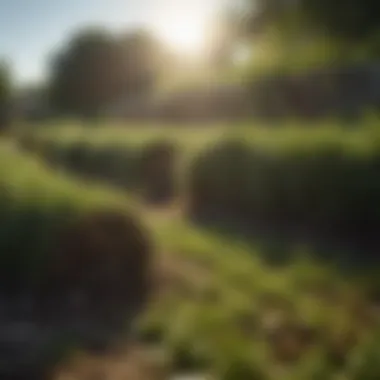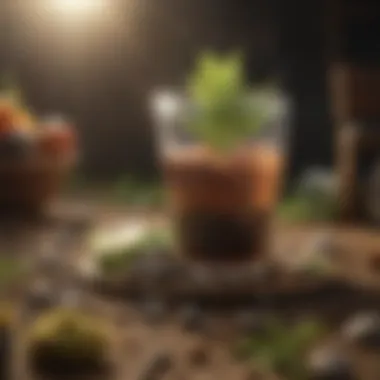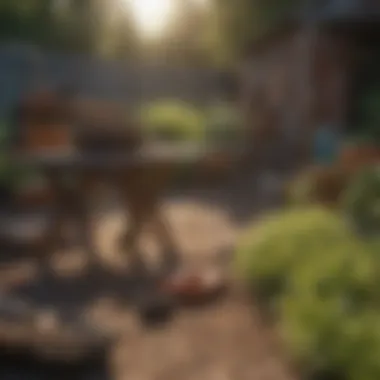Understanding Backyard Resodding Costs and Considerations


Intro
Resodding a backyard can offer a fresh landscape and rejuvenate your outdoor space. However, before diving into this project, understanding the associated costs and considerations is crucial. Various factors influence the expenses, including the size of the yard, the type of sod chosen, and labor requirements.
Awareness of these elements not only helps in budgeting but also aids in making strategic decisions for a sustainable and appealing yard. With the right knowledge, property owners can avoid common pitfalls and create an outdoor environment that enhances the property’s value and usability.
Preamble to Resodding
Resodding a backyard is a significant undertaking for homeowners and property managers alike. It encompasses various practical and financial aspects that must be understood before making decisions. The process not only affects the aesthetics of an outdoor space but also its overall health and usability. With the right approach, resodding can revitalize a tired lawn, providing a lush and vibrant environment for recreational activities and enhancing property value.
Moreover, an understanding of resodding prepares individuals for the costs involved and helps in the planning of the project. This section lays the groundwork for why resodding is essential, detailing its benefits and considerations.
Definition of Resodding
Resodding refers to the practice of replacing existing grass with new sod. This involves laying down pre-grown grass pieces that are cut to specific sizes and placed over prepared soil. Unlike seeding, which requires time for grass to grow, resodding provides an almost instant lawn. This method is often chosen for its efficiency and immediate results.
By opting for resodding, homeowners can quickly address issues like patchy grass, weeds, and unhealthy soil conditions. The process can restore a lawn's appearance and functionality, making it suitable for family gatherings, outdoor games, and other activities.
Reasons for Resodding a Backyard
Several reasons may lead a homeowner to consider resodding their backyard:
- Deterioration of Existing Lawn: Over time, lawns can become sparse or damaged due to various factors such as pests, diseases, or adverse weather conditions. Resodding offers a fresh start that can rejuvenate the lawn.
- Aesthetic Improvement: A new layer of sod can dramatically enhance the look of a backyard, providing a lush green carpet that is visually appealing.
- Functionality Needs: Some homeowners may require a lawn that can withstand heavy foot traffic or specific activities, necessitating the installation of more durable sod varieties.
- Increasing Property Value: A healthy and attractive lawn can improve the curb appeal of a property, making it more attractive to potential buyers if the home is for sale.
Overall, understanding the nuances of resodding equips homeowners with the knowledge to make informed decisions regarding their outdoor space.
Understanding the Costs
Factors Influencing Cost
Yard Size
Yard size is one of the most significant factors influencing the overall cost of resodding. A larger area naturally requires more sod and additional labor for installation. For instance, a backyard measuring 1,000 square feet will demand significantly more resources than one that is just 500 square feet. It is essential to measure the yard accurately to gauge how much sod is required.
The key aspect of understanding yard size is its direct correlation with the total sod cost. Larger areas can result in a higher upfront cost but may prove beneficial in the long run if maintained properly. However, this comes with disadvantages such as needing more care and resources.
Type of Sod
The type of sod selected directly affects the financial outlay. Different varieties of sod provide distinct benefits, such as durability, aesthetic appeal, and climate suitability. For example, Kentucky Bluegrass is popular for its lush color but often comes with a higher price tag and maintenance requirements compared to Bermuda grass, which is more drought-resistant and easier to care for.
Sod type selection is critical. Choosing a low-maintenance variety may enrich the backyard while also keeping ongoing costs lower. However, some sod types might not fit the local climate or usage needs, leading to poor performance and unnecessary replacement costs.
Preparation of Soil
The preparation of soil is also a crucial component of resodding costs. Proper soil preparation involves assessing and amending the soil to ensure a suitable environment for the new sod. This may include tilling, or adding organic matter, which can involve additional expenses. However, investing in good soil preparation can yield a more successful sodding project. Failure to prepare the soil adequately can lead to poor sod growth and even higher long-term costs if resodding becomes necessary sooner than expected.
The main features of soil preparation include its ability to enhance nutrient availability and water retention for new sod. The disadvantage is that it can be time-consuming and sometimes requires professional assistance, which adds to immediate costs.
Local Climate Conditions


Local climate conditions are integral in determining sod costs since not all types of grass thrive equally across different environments. For example, warm-season grasses flourish in southern regions, while cool-season grasses may be more suitable for northern climates. Understanding these conditions is essential for selecting the right sod and for calculating potential costs.
The primary characteristic of climate considerations is that local weather significantly impacts sod health and maintenance. Moreover, selecting the appropriate sod type according to climate can prevent the need for frequent replacement and lead to long-term savings. However, if one chooses a sod type not suited for local conditions, this decision could result in increased maintenance costs and risks.
Estimating Cost per Square Foot
Estimating cost per square foot is a practical step for budgeting a resodding project. Generally, this involves multiplying the sod cost per square foot by the total area of the yard. Some suppliers provide packaged rates, making it easier to compute costs. Also, additional factors like installation labor and soil preparation can increase this estimate further. Knowing the estimated cost per square foot can guide buyers in making informed choices about the quantity of sod they can procure.
Comparing Costs of Different Sod Types
Cool-Season Grasses
Cool-season grasses, such as Fescue and Kentucky Bluegrass, thrive in northern climates and have particular traits that impact cost. These grasses are usually more resilient to cold weather but may require more water and fertilization during hot seasons. Overall, their higher maintenance needs can lead to increased long-term costs, but they provide lush, green lawns in appropriate climates.
Choosing cool-season grasses can offer aesthetic advantages, but property owners must also consider their ongoing upkeep, which can be more intensive compared to some alternatives.
Warm-Season Grasses
Warm-season grasses, such as Bermuda or Zoysia, generally work well in southern regions. They adapt better to heat and drought conditions, making them less demanding in terms of moisture and care, which can mitigate overall costs. However, their performance may decline in colder months, necessitating consideration of seasonal variations.
When selecting warm-season grasses, owners typically enjoy lower maintenance costs and resilience during high temperatures. However, if the climate is not suited for these grasses, it may lead to poor growth each year, thereby increasing replacement costs.
Preparation for Resodding
Preparation is a crucial step when considering resodding your backyard. A well-planned approach can save both time and expenses, leading to a healthier lawn. This section will explore the essential components necessary for ensuring a successful resodding project.
Assessing Current Lawn Condition
Before any action is taken, examining the existing lawn condition is fundamental. Homeowners need to evaluate the current state of the yard. Look for signs of wear, including brown patches, weeds, and drainage issues. Assessing these factors helps identify what might have caused the decline in the lawn’s health.
- Visual Inspection: Examine the overall appearance of the grass.
- Soil Quality: Consider if the soil holds water well or dries too quickly.
- Weeds: Note any persistent weeds that could hinder new sod growth.
Identifying these issues early on will guide decisions in the preparation phase. For instance, extensive weed problems may require a treatment plan to eliminate them prior to laying down new sod.
Soil Testing and Amendments
After assessing the lawn, soil testing is vital. This process involves taking samples of the soil and analyzing them for nutrient content, pH level, and contaminants. Knowledge of these factors will inform necessary soil amendments.
Common amendments include:
- Lime: Used to raise the pH of acidic soils.
- Sulfur: Lowers pH levels in alkaline soils.
- Organic Matter: Improves soil structure and nutrient content.
Making appropriate amendments enhances the soil environment for new sod. By enriching the soil, homeowners can help ensure that sod takes root effectively, leading to a lush and healthy lawn.
Scheduling the Resodding
The timing of the resodding project influences its success. Homeowners must consider local climate conditions when scheduling. Ideal times for laying sod usually occur in early spring or early autumn, when temperatures are moderate. However, different grass types might have specific requirements, so it could depend on whether you're using cool-season or warm-season grasses.
Key factors to consider when scheduling:


- Weather Conditions: Avoid extremely hot or cold days for installation.
- Sod Delivery: Ensure that sod arrives fresh and is used promptly.
- Preparation Time: Allow enough time to prepare the soil and resolve any existing lawn issues.
Furthermore, a well-timed resodding can effectively reduce establishment period, allowing the new lawn to thrive more quickly. By carefully planning these elements, the transition to a resodded backyard can proceed smoothly, setting the stage for a successful outcome.
DIY vs. Professional Resodding
The decision whether to tackle resodding as a do-it-yourself project or to hire professionals is a significant one. Each option presents distinct advantages and drawbacks. Understanding these will help homeowners effectively weigh their choices. The approach can impact not only financial implications but also the quality and longevity of the sod installed in the backyard. Factors such as personal skills, time availability, and budget constraints all come into play. Therefore, it is essential to examine each option closely.
Advantages of DIY Resodding
Opting for DIY resodding can lead to notable cost savings. Homeowners can skip labor costs by doing the job themselves. However, the savings do not only stem from labor. There is a sense of personal achievement in transforming one’s yard. Additionally, one can select sod that appeals specifically to their taste without vendor pressure. Adopting a hands-on approach allows for more control over the project timeline. Further, there is an opportunity to learn valuable lawn care skills.
Despite these benefits, one must approach DIY resodding with caution. It requires substantial physical effort and time. Inexperienced homeowners may face challenges in proper sod installation or soil preparation. Poor installation could lead to problems like patchy growth or sod failure, which could incur additional costs in the long run.
Benefits of Hiring Professionals
In contrast, hiring professionals for resodding presents its own advantages. Professional landscapers bring expertise, experience, and efficiency to the project. They possess the required tools and resources necessary for the job, ensuring a quality installation. This can lead to a more uniform and sustainable result. Their knowledge aids in choosing the right type of sod for the specific climate and yard conditions. Moreover, professionals will typically handle the proper preparation of soil, which is crucial for the long-term health of the lawn.
While the upfront cost may be higher, the potential for long-term savings exists. A well-laid sod by experts can reduce the likelihood of future issues related to lawn health. Furthermore, many professionals offer warranties, providing peace of mind for homeowners.
Cost Analysis of Both Approaches
Analyzing the overall costs of DIY versus professional resodding involves more than just the initial outlay. Here are some key considerations:
- DIY Cost
- Professional Cost
- Sod Price: Typically ranges between $0.30 to $0.80 per square foot.
- Tools Needed: Equipment rental or purchase (e.g., sod cutter, soil tiller).
- Time Investment: Consider potential loss of productivity.
- Labor Fees: Cost is often between $1 to $2 per square foot, including all labor.
- Materials: May include additional charges for soil amendments and rental of specialized equipment.
- Service Guarantees: Potential costs covered if future issues arise.
Ultimately, the choice between DIY and professional resodding will depend on the individual homeowner's circumstances. Factors like skill level, available time, and budget should guide this decision. Thorough understanding of the costs associated with each approach can help determine the most suitable path for a successful backyard transformation.
Post-Installation Considerations
Post-installation considerations are critical for the long-term health of your newly resodded backyard. These steps can either enhance or undermine your investment in sod. Understanding what follows after the installation will give you the best chance for a lush and vibrant lawn. Each aspect of post-installation care plays a significant role in ensuring that the sod takes root successfully and flourishes over the seasons. Below are several key elements to consider.
Initial Watering Requirements
Once the sod is laid down, proper watering is essential for its establishment. It is typically advised to water the new sod immediately after installation. This initial watering should be thorough enough to saturate the soil beneath. The goal is to keep the sod moist but not waterlogged. Over the first two weeks, aim to water daily, ensuring the soil stays damp.
Some pointers for effective watering:
- Duration: Water each section for about 20-30 minutes, depending on the weather.
- Soil Monitoring: Check the soil moisture daily by lifting a corner of the sod; if it feels dry, it's time to water.
- Avoid Runoff: Ensure your watering method does not lead to excessive runoff, as this can prevent water from reaching the roots.
Adjustments may be needed based on local climate conditions. In hotter climates, you might need to increase watering frequency.
Mowing and Maintenance Schedule
Once the sod has rooted in, usually after about two weeks, it's time for the first mow. However, resist the urge to mow too soon. Cutting the new sod before its roots establish can cause damage. When ready to mow, follow these guidelines:


- Height: Set your mower blades to a higher setting to avoid cutting too much off at once. Leaving the grass longer promotes root growth.
- Frequency: Consider mowing every week during the growing season, depending on the grass type and growth rate.
- Clippings: Leave the grass clippings on the lawn to retain moisture and provide nutrients.
Regular maintenance is key. This includes keeping an eye out for weeds or other issues that could harm the lawn.
Fertilization and Pest Management
Fertilization boosts the health of your sod. After about four to six weeks post-installation, apply a balanced lawn fertilizer. This step provides necessary nutrients for robust growth. Here are some considerations for fertilizing:
- Type of Fertilizer: Use a slow-release fertilizer to ensure a gradual supply of nutrients.
- Frequency of Application: A regular schedule that aligns with the growing season can be effective. Typically, fertilization is done every 4-6 weeks during the growing season.
In addition to fertilization, it's essential to manage pests that can threaten your lawn. Inspect regularly for signs of pest damage or disease. Consider these actions:
- Identification: Identify common pests in your area to manage them effectively.
- Treatment Options: Depending on the severity of the issue, natural or chemical treatments may be suitable.
Through careful watering, mowing, and maintenance, you can significantly increase the longevity and health of your sod, ensuring your backyard remains a thriving space.
Long-Term Cost Implications
Understanding the long-term cost implications of resodding a backyard is essential for homeowners seeking to make informed decisions. Resodding can have significant financial impacts that extend beyond the initial investment. Thus, it is worth taking the time to assess various factors that can influence overall expenses over time.
Comparative Lifespan of Different Sod Types
When considering the longevity of sod types, the differences become clear. Each variety caters to specific climates and soil conditions. For instance, Zoysia grass is known for its drought tolerance and durability, making it a long-term choice in warmer areas. On the contrary, Kentucky bluegrass, while visually appealing, may require more frequent replacement in hot and humid climates. Evaluating these differences is crucial for making a sustainable choice.
The lifespan of sod is typically measured in years, but high-quality installations can last longer with proper care. Here’s a brief comparison:
- Bermudagrass: 3-5 years (ideal for warmer regions)
- Tall fescue: 5-10 years (suitable for transition zones)
- Perennial ryegrass: 1-2 years (often used for quick patches)
Investing in sod types with longer lifespans can lead to reduced resodding frequency. This means less expense on replacement and installation in the long run.
Long-Term Maintenance Costs
Long-term maintenance costs are another critical area to consider when planning for resodding. Maintenance encompasses watering, mowing, fertilization, and pest control. These ongoing commitments impact the overall cost of your lawn.
- Watering can become a major ongoing expense. In dry climates, this cost is more accentuated. Using drought-resistant sod types can lower these costs over time.
- Fertilization is necessary to maintain healthy grass. The frequency and type of fertilizer needed depend on the sod variety and local soil nutrients. Higher-quality sod type often requires less frequent fertilization, thus lowering expenses.
- Pest management also plays a role. Certain sod types are more resistant to pests and diseases, which reduces the need for chemical treatments.
Investing in quality sod and understanding its maintenance can lead to significant savings over time.
In summary, examining the comparative lifespan and long-term maintenance costs of different sod types will greatly influence the financial viability of your resodding project. Homeowners who take these factors into account can better prepare for the future, ensuring their investments contribute to a thriving and cost-effective lawn.
Epilogue
A well-prepared strategy can mitigate unexpected expenses in the long run. By taking into account the yard size, local climate conditions, and the specific needs of the chosen grass type, homeowners can effectively establish a resilient lawn that enhances their outdoor aesthetics and functionality.
Recap of Key Considerations
When considering resodding, several key points arise:
- Yard Size: Larger areas invariably require more sod and preparation efforts.
- Sod Type: Different grass varieties come at diverse price points and care needs.
- Preparation of Soil: Proper soil testing and amendments can save costs on sod.
- Local Climate Conditions: Understanding climate influences sod performance and health.
Each of these factors contributes significantly to both the initial costs and the future sustainability of the resodded area. Ignoring these elements could lead to losing investments and hindered growth.
Final Thoughts on Resodding
In closing, resodding a backyard is not simply a task but an investment in your outdoor living space. Taking time to research and plan the process thoroughly ensures that the choices made are in the best interest of the property and its occupants.
Educating oneself on the specifics of each aspect discussed in this article often leads to better long-term outcomes. It transforms a potentially daunting task into an empowering experience, allowing individuals to create a beautiful, functional lawn that meets their needs. It is advised to remain practical about desires and expectations. Resodding can improve not only the visual appeal but also promote environmental health by supporting local ecosystems. Therefore, this undertaking is vital for both personal satisfaction and broader ecological contributions.



